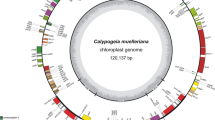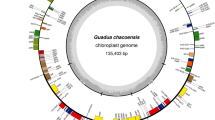Abstract
Duckweeds, the fastest growing angiosperms, are gaining increasing attention with respect to their practical applications. Different clones of the same duckweed species vary in their physiological properties. Hence, screening of suitable clones of a species is very important. To enable the identification of clones, a clear taxonomic classification and barcoding at different taxonomic levels, i.e. genera, species, and clones is a pre-requisite. In the present project, we have focused on the genera Spirodela and Landoltia. Spirodela polyrhiza (L.) Schleid. (42 clones), Spirodela intermedia W. Koch (14 clones), and Landoltia punctata (G. Meyer) Les & Crawford (15 clones) were characterized using three plastidic sequences (rpl16, rps16, atpF-atpH) and AFLP fingerprinting. Genome size determination showed significant differences between the two genera. The genetic variability is lowest in S. polyrhiza and highest in S. intermedia. Although the resolution of phenetic variability by AFLP fingerprinting is much higher than the sequence variation of the selected plastidic regions, not all clones could be identified unequivocally. However, without any exception, all clones were strictly categorized into the three species as defined by the morphological markers. The results do not justify the separation of some clones as Spirodela biperforata from S. intermedia.







Similar content being viewed by others
References
Appenroth, K.-J., S. Teller & M. Horn, 1996. Photophysiology of turion formation and germination in Spirodela polyrhiza. Biologia Plantarum 38: 95–106.
Appenroth, K. J., N. Borisjuk & E. Lam, 2013. Telling duckweed apart: Genotyping technologies for Lemnaceae. Chinese Journal of Applied and Environmental Biology 19: 1–10.
Blazey, E. B. & J. W. McClure, 1968. The distribution of taxonomic significance of lignin in the Lemnaceae. American Journal of Botany 55: 1240–1245.
Bog, M., H. Baumbach, U. Schween, F. Hellwig, E. Landolt & K.-J. Appenroth, 2010. Genetic structure of the genus Lemna L. (Lemnaceae) as revealed by amplified fragment length polymorphism. Planta 232: 609–619.
Bog, M., P. Schneider, F. Hellwig, S. Sachse, E. Z. Kochieva, E. Martyrosian, E. Landolt & K.-J. Appenroth, 2013. Genetic characterization and barcoding of taxa in the genus Wolffia Horkel ex Schleid. (Lemnaceae) as revealed by two plastidic markers and amplified fragment length polymorphism (AFLP). Planta 237: 1–13.
Borchert, T., J. Fuchs, T. Winkelmann & A. Hohe, 2007. Variable DNA content of Cyclamen persicum regenerated via somatic embryogenesis: rethinking the concept of long-term callus and suspension cultures. Plant Cell Tissue and Organ Culture 90: 255–263.
Campbell, G. & J. H. Skillings, 1985. Nonparametric stepwise multiple comparison procedures. Journal of the American Statistical Association 80: 998–1003.
Doležel, J., J. Bartos, H. Voglmayr & J. Greilhuber, 2003. Nuclear DNA content and genome size of trout and human. Cytometry 51A: 127–128.
Doležel, J., J. Greilhuber & J. Suda, 2007. Estimation of nuclear DNA content in plants using flow cytometry. Nature Protocols 2: 2233–2244.
Doyle, J. J. & E. E. Dickson, 1987. Preservation of plant samples for DNA restriction endonuclease analysis. Taxon 36: 715–722.
Doyle, J. J. & J. L. Doyle, 1987. A rapid DNA isolation procedure for small quantities of fresh leaf tissue. Phytochemical Bulletin 19: 11–15.
Ehrich, D., 2006. AFLPdat: a collection of R functions for convenient handling of AFLP data. Molecular Ecological Notes 6: 603–604.
Evanno, G., S. Regnaut & J. Goudet, 2005. Detecting the number of clusters of individuals using the software structure: a simulation study. Molecular Ecology 14: 2611–2620.
Falush, D., M. Stephens & J. K. Pritchard, 2007. Inference of population structure using multilocus genotype data: dominant markers and null alleles. Molecular Ecological Notes 7: 574–578.
Galbraith, D. W., K. R. Harkins, J. M. Maddox, N. M. Ayres, D. P. Sharma & E. Firoozabady, 1983. Rapid flow cytometric analysis of the cell cycle in intact plant tissues. Science 220: 1049–1051.
Gao, X., A. Mayer, C. Jie & L. Gang, 2008. Nonparametric multiple comparison procedures for unbalanced one-way factorial designs. Journal of Statistical Planning and Interference 138: 2574–2591.
Hall, T. A., 1999. BioEdit: a user-friendly biological sequence alignment editor and analysis program for Windows 95/98/NT. Nucleic Acids Symposium Series 41: 95–98.
Holland, B. R., A. C. Clarke & H. M. Meudt, 2008. Optimizing automated AFLP scoring parameters to improve phylogenetic resolution. Systematic Biology 57: 347–366.
International Steering committee on Duckweed Research and Application, 2013. NewsLetter No. 1. http://www.internationallemnaassociation.org/uploads/Intl_Duckweed_Committee_Letter_No._1.pdf.
Jordan, W. C., M. W. Courtney & J. E. Neigel, 1996. Low levels of intraspecific genetic variation at a rapid evolving chloroplast DNA locus in North American duckweeds (Lemnaceae). American Journal of Botany 83: 430–439.
Koch, W., 1932. Beitrag zur Lemnaceen-flora mittel und Suedamerikas. Berichte der Schweizerischen Botanischen Gesellschaft 41: 113–118.
Koch, W., 1933. Spirodela biperforata, eine neue Teichlinse aus Surinam. Berichte der Schweizerischen Botanischen Gesellschaft 42: 186–189.
Konietschke, F., X. Gao & A. C. Bathke, 2013. Comment on ‘Type I error and test power of different tests for testing interaction effects in factorial experiments. Statistica Neerlandica 67: 400–402.
Kuehdorf, K., G. Jetschke, L. Ballani & K.-J. Appenroth, 2014. The clonal dependence of turion formation in the duckweed Spirodela polyrhiza – an ecogeographical approach. Physiologia Plantarum 150: 46–54.
Lam, E., K. J. Appenroth, T. Michael, K. Mori & T. Fakhoorian, 2014. Duckweed in bloom: the 2nd international conference on duckweed research and applications heralds the return of a plant model for plant biology. Plant Molecular Biology 84: 737–742.
Landolt, E., 1980. Biosystematic investigations in the family of duckweeds (Lemnaceae). Key to determination, Vol. 1. Veroeffentlichungen des Geobotanischen Institutes der ETH, Stiftung Ruebel, Zurich: 13–21.
Landolt, E., 1986. The family of Lemnaceae – a monographic study. Biosystematic investigations in the family of duckweeds (Lemnaceae), Vol. 1. Veröffentlichungen des Geobotanischen Institutes der ETH, Stiftung Rübel, Zürich.
Les, D. H. & D. J. Crawford, 1999. Landoltia (Lemnaceae), a New Genus of Duckweeds. Novon 9: 530–533.
Les, D. H., D. J. Crawford, E. Landolt, J. D. Gabel & R. T. Kimball, 2002. Phylogeny and systematics of Lemnaceae, the duckweed family. Systematic Botany 27: 221–240.
McClure, J. W. & R. E. Alston, 1966. A chemotaxonomic study of Lemnaceae. American Journal of Botany 53: 849–860.
Meier, R., S. Kwong, G. Vaidya & P. K. L. Ng, 2006. DNA Barcoding and Taxonomy in Diptera: a Tale of High Intraspecific Variability and Low Identification Success. Systematic Biology 55: 715–728.
Meister, J., M. Hubaishan, N. Kilian & C. Oberprieler, 2006. Temporal and spatial diversification of the shrub Justicia areysiana Deflers (Acanthaceae) endemic to the monsoon affected coastal mountains of the southern Arabian Peninsula. Plant Systematics and Evolultion 262: 153–171.
Oxelman, B., M. Liden & D. Berglund, 1997. Chloroplast rps16 intron phylogeny of the tribe Silenae (Caryophyllaceae). Plant Systystematics and Evolution 206: 393–410.
Pritchard, J. K., 2010. Documentation for structure software: version 2.3. Software documentation from http://pritch.bsd.uchicago.edu/structure.html.
Pritchard, J. K., M. Stephens & P. Donelly, 2000. Inference of population structure using multilocus genotype data. Genetics 155: 945–959.
R Development Core Team, 2012. R: a language and environment for statistical computing. R Foundation for Statistical Computing, Vienna, Austria. http://www.R-project.org.
Ryzhova, N. N., L. V. Martyrosian, T. V. Kolganova, S. V. Goryunova & E. Z. Kochieva, 2006. Characterization of the trnL-trnF spacer sequence of the chloroplast tRNA genes in Spirodela species. Molecular Biology 40: 891–896.
Schmidt-Lebuhn, A. N., J. Fuchs, D. Hertel, H. Hirsch, J. Toivonen & M. Kessler, 2010. An Andean radiation: polyploidy in the tree genus Polyepis (Rosaceae, Sanguisorbeae). Plant Biology 12: 917–926.
Small, R. L., E. B. Lickey, J. Shaw & W. D. Hauk, 2005. Amplification of noncoding chloroplast DNA for phylogenetic studies in lycophytes and monilophytes with a comparative example of relative phylogenetic utility from Ophioglossaceae. Molecular Phylogenetics and Evolution 36: 509–522.
Vos, P., R. Hogers, M. Bleeker, M. Reijans, T. Van de Lee, M. Hornes, A. Frijters, J. Pot, J. Peleman, M. Kuiper & M. Zabenau, 1995. AFLP: a new technique for DNA fingerprinting. Nucleic Acids Research 23: 4407–4414.
Wang, W., Y. Wu, Y. Yan, M. Ermakova, R. Kerstetter & J. Messing, 2010. DNA barcoding of the Lemnaceae, a family of aquatic monocots. BioMedCentral Plant Biology 10: 205–214.
Wang, W., R. A. Kerstetter & T. P. Michael, 2011. Evolution of genome size in duckweeds (Lemnaceae). Journal of Botany. Article ID 570319. doi:10.1155/2011/570319.
Wang, W., G. Haberer, H. Gundlach, C. Glaesser, T. Nussbaumer, M. C. Luo, A. Lomsadze, M. Borodovsky, R. A. Kerstetter, J. Shanklin, D. W. Byrant, T. C. Mockler, K. J. Appenroth, J. Grimwood, J. Jenkins, J. Chow, C. Choi, C. Adam, X.-H. Cao, J. Fuchs, I. Schubert, D. Rokhsar, J. Schmutz, T. P. Michael, K. F. X. Mayer & J. Messing, 2014. The Spirodela polyrhiza genome reveals insights into its neotenous reduction fast growth and aquatic lifestyle. Nature Communication. doi:10.1038/ncomms4311.
Ward, D. B., 2011. Spirodela oligorrhiza (Lemnaceae) is the correct name for the lesser greater duckweed. Journal of the Botanical Research Institute of Texas 5: 197–203.
Wiersema, J., 2014. Application of the name Lemna punctata G. Mey., the type of Landoltia Les & D. J. Crawford. Plant Biology. doi:10.1111/plb.12209.
Zhao, H., K. Appenroth, L. Landesman, A. A. Salmean & E. Lam, 2012. Duckweed rising at Chengdu: summary of the 1st international conference on duckweed application and research. Plant Molecular Biology 78: 627–632.
Ziegler, P., K. Adelmann, S. Zimmer, C. Schmidt & K.-J. Appenroth, 2014. Relative in vitro growth rates of duckweeds (Lemnaceae) – the most rapidly growing higher plants. Plant Biology. doi:10.1111/plb.12184.
Acknowledgments
We thank the German Research Foundation, Bonn, Germany for supporting this project (AP 54/10-1). We thank Prof. Dr. Frank Hellwig, Institute of Plant Systematics, Friedrich Schiller University of Jena, and Dr. Elena Z. Kochieva, Bioengineering Centre, Russian Academy of Sciences, Moscow, Russia, for their support, and Ms. Heike Ernst, IPK Gatersleben for making the photographs.
Author information
Authors and Affiliations
Corresponding author
Additional information
Handling editor: Stuart Anthony Halse
Prof. em. Dr. Elias Landolt deceased on 1st April 2013.
Electronic supplementary material
Below is the link to the electronic supplementary material.
10750_2014_2163_MOESM1_ESM.xlsx
Supplementary material 1 (XLSX 13 kb) Supplementary Table S1: Genome sizes of clones of the species S. intermedia, S. polyrhiza, and L. punctata
10750_2014_2163_MOESM2_ESM.xlsx
Supplementary material 2 (XLSX 144 kb) Supplementary Table S2: 0/1-matrix of AFLP investigations of clones of S. intermedia, S. polyrhiza, and L. punctata (Sheet 1) as well as fixed and private bands (Sheet 2) and possible identical clone pairs as identified by the ‘Clones.list’ function of AFLPdat (Sheet 3)
Rights and permissions
About this article
Cite this article
Bog, M., Lautenschlager, U., Landrock, M.F. et al. Genetic characterization and barcoding of taxa in the genera Landoltia and Spirodela (Lemnaceae) by three plastidic markers and amplified fragment length polymorphism (AFLP). Hydrobiologia 749, 169–182 (2015). https://doi.org/10.1007/s10750-014-2163-3
Received:
Revised:
Accepted:
Published:
Issue Date:
DOI: https://doi.org/10.1007/s10750-014-2163-3




